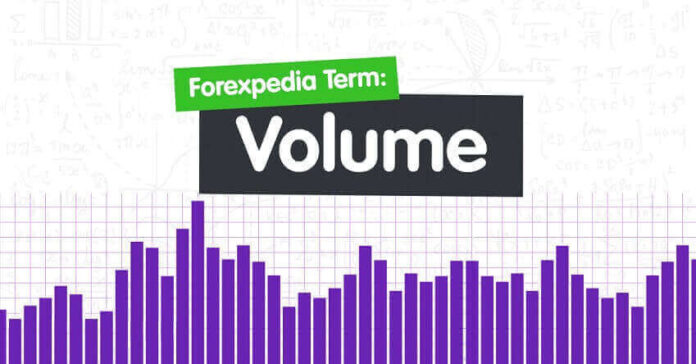Volume
Volume is a measure of quantity.
In trading, the volume is the amount of a particular asset traded over a period of time.
It is the number of units, shares, or contracts that change hands between a buyer and a seller.
The more actively traded an asset is, the higher the volume will be (and vice versa).
Volume is a key indicator of market activity and liquidity, which means that it is often presented alongside price information.
Whenever a contract is traded, there has to be a buyer and a seller in order for the transaction to take place.
Each transaction is a single exchange and will contribute to the trading volume.
It is worth noting that the number of actual transactions is not given in the trading volume, it is the number of assets traded that is counted.
So, if 100 buyers purchase one share each it looks the same as if one buyer purchases 100 shares.
When a market is described as “active” it indicates that the trading volume will be higher, and if the market is described as “inactive” it means that the trading volume will be lower.
The trading volume is usually higher when there is a significant price fluctuation in the market.
Volume can be used to measure stocks, bonds, options, futures, commodities, and forex.
However, volume is used most often in stock trading, where it shows the number of shares that are being traded.
As volume offers an extra dimension when examining an asset’s price action, it is a popular tool in the technical analysis of financial markets.
It helps determine the strength of price movements.
If a price movement is accompanied by a proportionate increase in volume, it is seen as more significant than one that isn’t.
Each market or exchange will track its own volume and distribute the data to traders. These volume reports usually come out in real-time, but they are only estimates.
For accurate volume figures, traders usually have to wait until the end of the day.
However, there are other ways that traders can determine market volumes, such as the tick volume or the number of price changes.
If the market price is changing rapidly, it can be an indicator of the high trading volume.
Importance of Volume in Technical Analysis
Volume is an important aspect of technical analysis because it is used to confirm trends and chart patterns.
Whenever the price of an asset increases or decreases with relatively high volume, it is viewed as a stronger, more significant move.
If the price fluctuates in a similar manner but the volume is relatively low, then the move is viewed as weak.
This is why it’s important to analyze both the price movement as well as the volume in order to gauge the validity of trend reversals, trend continuations, and chart patterns.
Technical analysis of an asset’s volume helps traders determine if certain situations are occurring, such as a true trend reversal.
For example, if bitcoin jumps 20% in one trading day after being in a long downtrend. If the volume is high during the day relative to the average daily volume, it is a sign that it is reversing its trend.
On the other hand, if the volume is below average, there may not be enough indication to support a true trend reversal.
Volume precedes price.
An important belief in technical analysis is that an asset’s price is preceded by its volume.
Volume is closely monitored by traders to form predictions of upcoming trend reversals.
An example of this belief is when the volume is starting to decrease in an uptrend, it is usually recognized as a sign that the upward price movement is about to end.
Volume should confirm the trend.
If the price is moving in an upward trend, the volume should increase. If the price is moving in a downward trend, the volume should also increase
If the previous relationship between volume and price movements starts to deteriorate, it is usually a sign of weakness in the trend.
For example, if the price is in an uptrend but the up trading days are marked with lower volume, it is a sign that the trend is starting to lose its legs and may soon end.
Volume should confirm chart patterns.
Patterns such as Head and Shoulders, Triangles, Flags, and other chart patterns should be confirmed by volume.
For example, during an upside breakout in an Ascending Triangle, it should be confirmed with an increased amount of volume.
If the volume is not there to confirm the breakout move, the quality of the signal formed by the chart pattern is weakened.
If this article seems useful to your then please click the like button below. You can also share your valuable feedback or ask questions in the below comment section. Also, subscribe to our newsletter for trading-related updates.







